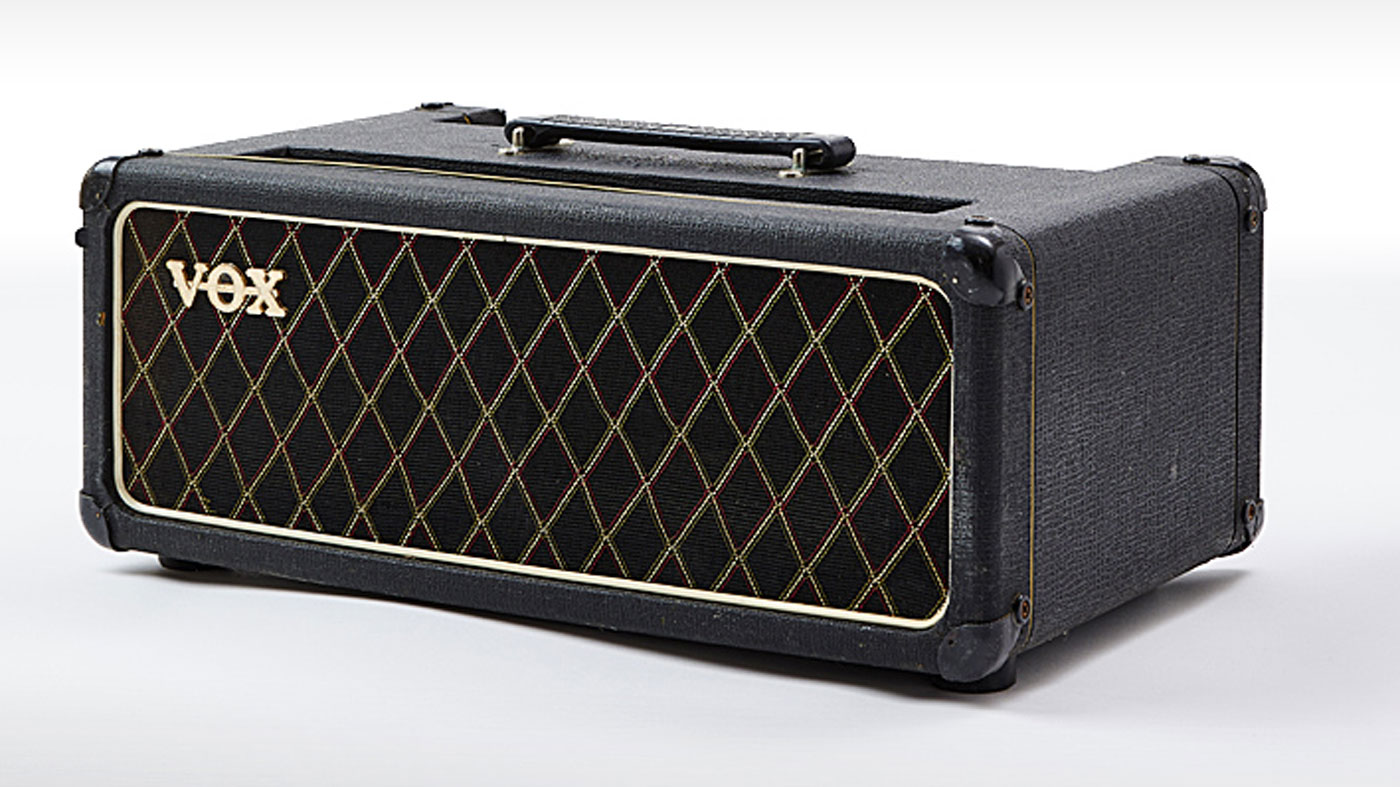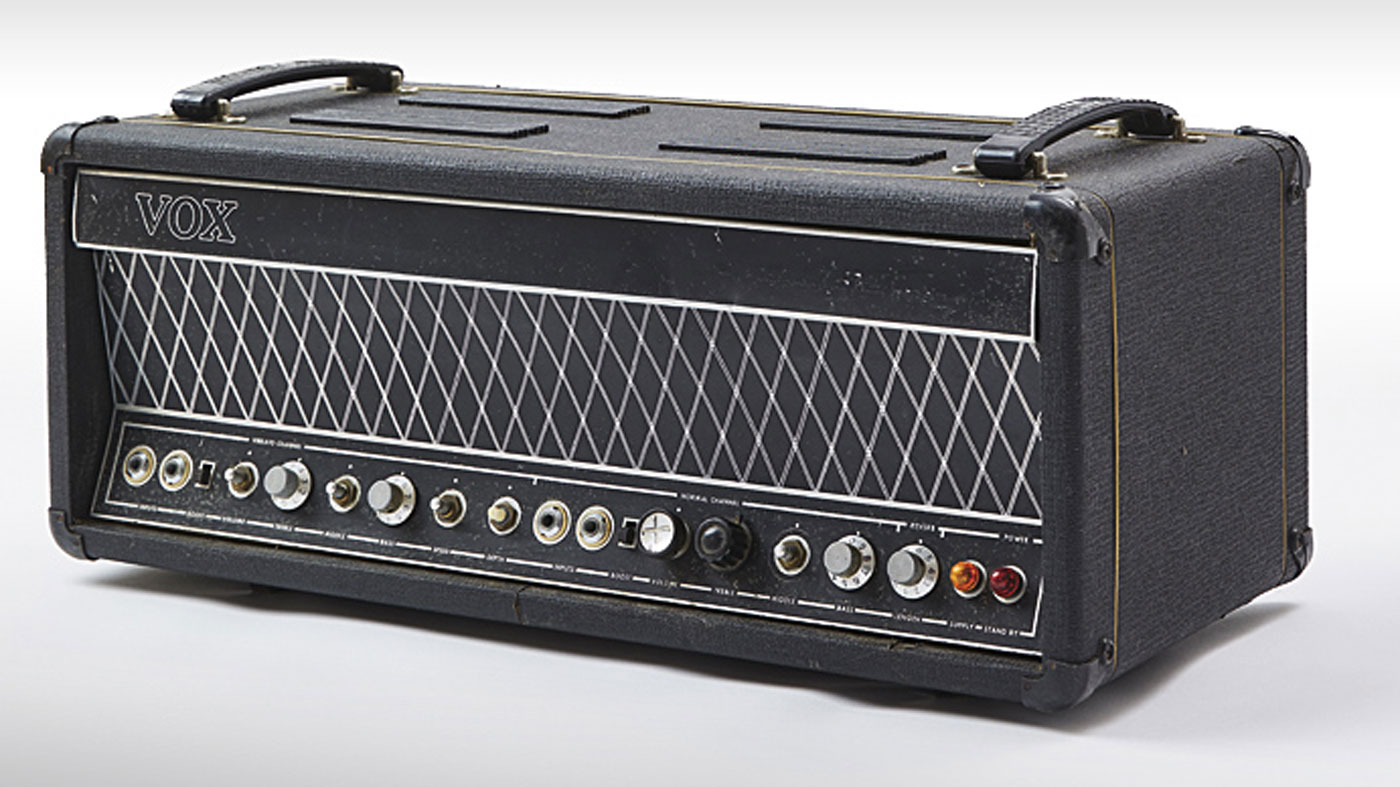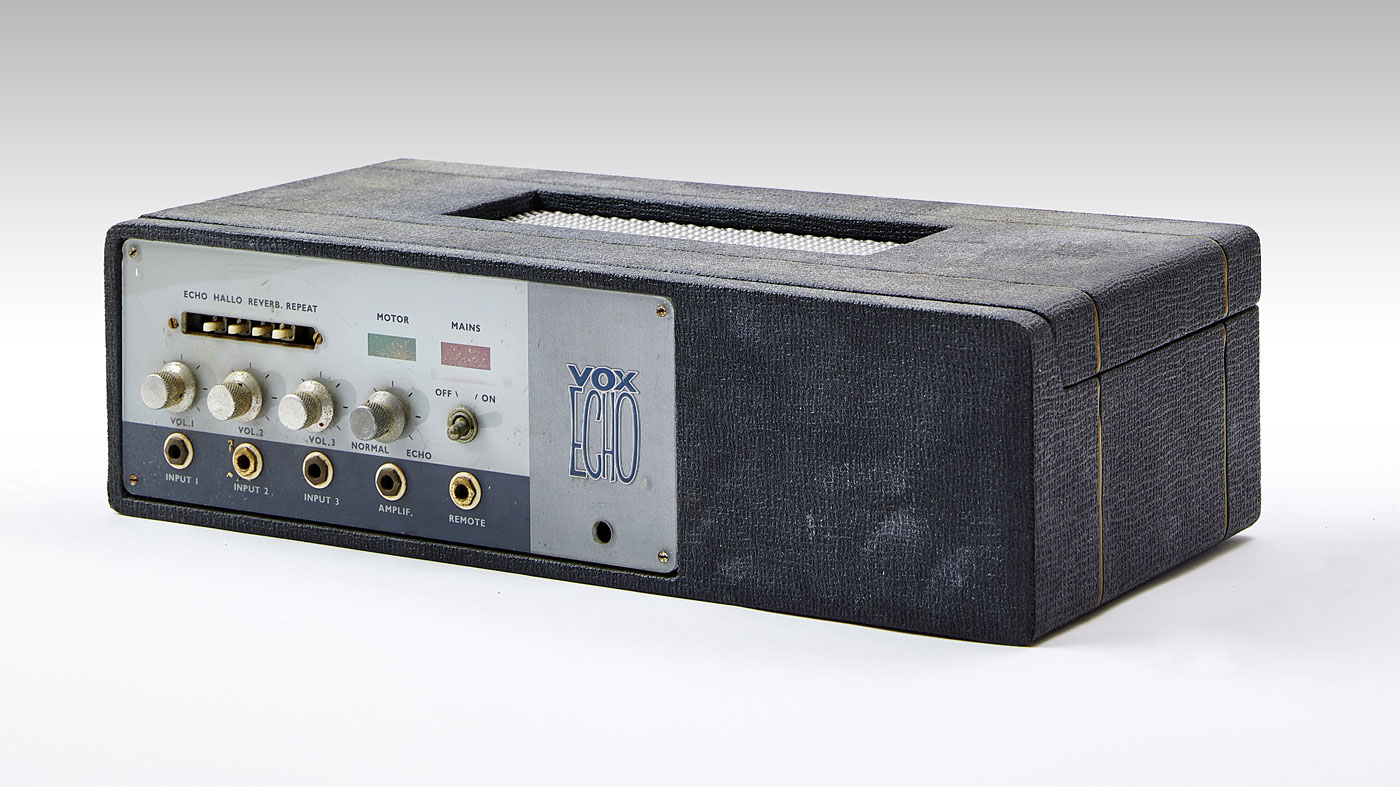
In 1957 two mavericks formed an amp company that would define the sound of British rock. We look back on 60 years celebrating six decades of tones.
Earlier this year, a commemorative blue plaque was unveiled at the site of the fi rst Vox factory in Dartford, Kent. It reads: “From these premises, music entrepreneur Tom Jennings and sound engineer Dick Denney produced the fi rst Vox amplifier, changing the sound of popular music forever.”
The real breakthrough, the amplifier that would establish what we now celebrate as ‘The Vox Sound’ was the AC15
Actually, one of the first Vox products was a poorly-selling 3.5-watt practice amp with a 6.5” speaker. The only thing it changed was Dick Denney’s mind when he chose to upscale the speaker chassis to an eight-inch version. Even then, it was poorly equipped to take on existing combos like the WEM Clubman…
The real breakthrough, the amplifier that would establish what we now celebrate as ‘The Vox Sound’ was the AC15. The momentum created by this landmark 15-watt combo led to Rolling Stone Brian Jones’ MKVI ‘Teardrop’ guitar, the Vox wah, the Tone Bender fuzz, and the greatest British backline treasure of them all, the iconic AC30.
It was in 1956 that Dick Denney first showed Tom Jennings his homebuilt 15-watt amplifier. A little over a year later, the entrepreneur and the engineer pooled their experience in a new venture called Jennings Musical Industries aka ‘JMI’. It was a landmark moment but it’s not the beginning of the Jennings story.
As former Vox employee, celebrated electronics genius and ‘Father of British EQ’, John Oram explains, the origins of JMI can actually be traced back to the end of World War II and an outfit called Jennings Organ Company.

“A lot of people who know Vox for the guitar side don’t realise the company was running years before the amplifier thing, just on Tom Jennings selling accordions... and teaching accordion. That was down at Dartford, next to a fish and chip shop.”
Want all the hottest music and gear news, reviews, deals, features and more, direct to your inbox? Sign up here.
Oram began an apprenticeship at the JMI parent company Royston Industries in 1964. Just about the last man standing from the original lineup at JMI in the 60s, he worked on the Vox wah, the AC50 and early solidstate gear like the Super Beatle stack. He’s an invaluable source of anecdotes, not to mention an excellent tour guide into a very different world.
“I first saw Tom when I was about five or six years old,” says Oram. “He used to wait for kids to come out of school, and he would follow them home, with an accordion on his back, riding a bicycle. He would wait ‘til you’d gone in, usually with your mum, cos at that age you were escorted home. You’d get in and there would be a knock on the door and - this actually happened to me, so I’m speaking from experience - mum would answer the door and Tom would be there with his accordion, playing it. With a big smile on his face!
“He’d say, ‘Madam, I see you’ve got a very nice little boy there. How would you like him to be able to play accordion like this?’”
Skiffle scattered
Sadly for Jennings, by the mid-50s, few kids wanted to be seen dead with an accordion. The skiffle craze, led by Chas McDevitt and Lonnie Donegan, had British ‘yoof’ pestering their parents for acoustic guitars, or raiding garden sheds or the local dump for tea chests and washboards.
In 1956, Elvis Presley’s Heartbreak Hotel effectively signed skiffle’s death warrant, although it took another year or so for rigour mortis to set in good and proper. When Paul McCartney first encountered John Lennon at a church fete in Woolton, Liverpool in 1957, his future Beatle bandmate was still playing skiffle with The Quarrymen. It wouldn’t be long before kids like John and Paul were turned on by the sound of amplified guitar courtesy of Elvis sideman Scotty Moore, Chuck Berry and a Lubbock, Texas kid called Buddy Holly.
Holly electrified the imagination of a generation when he appeared on the cover of his album cradling a sunburst Fender Stratocaster
Holly electrified the imagination of a generation of kids when he appeared on the cover of his album The “Chirping” Crickets cradling a sunburst Fender Stratocaster. Whatever the kids had been into up to that point was finished, British rock was in the post and, what’s more, there was an embargo on American goods. Tom Jennings and Dick Denney’s timing couldn’t have been more perfect. The engineer set about refining his prototype.
Originally designated the AC-1, the amp that would become better known as the AC15 was unveiled in 1958. Denney nailed the classic Vox formula with the AC15. For a start he plumped for EL-84 output valves, which, when pushed hard, distort due to their low headroom. In the 1950s, distortion was still considered a fault and an engineer like Denney would reduce unwanted fuzz using a ‘negative feedback’ circuit, a device that sends some of the amp’s signal back into the power amp.
The eureka moment came when Denney decided he didn’t like the effect these problem-solving gubbins had on the sound of the amplifier. Drop kicking convention to the wind he engineered his new Class A combo without the circuitry. The AC15 would now produce overdrive when pushed hard.
As John Oram reveals, Dick Denney always had the last say on a new amp’s ‘voice’ despite having one key disadvantage.
“Dick was always hard of hearing,” Oram says.” You’d speak to him at a normal level and he wouldn’t know you were talking. You’d have to yell at him. I’ve always said that when Dick Denney voiced the sound on an amplifier he probably wasn’t hearing what we were hearing at all. He was hearing a more mellow sound perhaps. He had to tweak it so it was crisp for him. That created the Vox sound.”

Fun with Dick and John
Dick Denney wasn’t the only one that heard something special in the AC15. Artist endorsement was in its infancy in the late 1950s but JMI trumped the competition when it supplied three of its new amplifiers to The Shadows to replace their existing Selmer backline.
“Charlie Cobbett used to be the artist liaison manager for Vox,” says John Oram. “He was the one who used to go out and find the bands that Vox could give their gear to. That’s why they became so popular. They used to run adverts that said ‘95 per cent of bands played Vox’ but the top bands were given the gear for free. In exchange, whenever they went for a photo shoot, or if there was any TV show or whatever, there had to be Vox amplifiers on stage, even if they weren’t being used.
When The Shadows and Cliff Richard did Sunday Night At The London Palladium, the Vox amps would be there, all clean and tidy, glistening
“When The Shadows and Cliff Richard did Sunday Night At The London Palladium, in those days they had a rotating stage. And when it came round, the Vox amps would be there, all clean and tidy, glistening. And in use, of course. At that juncture, it was all live. But when they went to the Ed Sullivan Show in America, they didn’t play in the first show. They were just interviewed but they had to have those Vox amps in the background behind them. That was the rule of the game.”
Vox became the go-to brand for, of course, The Beatles, The Rolling Stones, The Kinks, and just about every provincial beat group with a recording contract. Most used their free Vox gear with gratitude and without incident. That is, until a bunch of louts from Shepherds Bush rolled up.
“The most unsuccessful band for Vox were The Who,” sighs Oram. “Charlie Cobbett nobbled them and got them signed up. They came, took the gear away for a gig on a Saturday night. On the Monday, the driver was back. There’s the gear, all smashed up. I think Tom put up with it for three sets of kit and then, in his own terms, said ‘You guys can fuck off!’”
Legend has it that when Who guitarist Pete Townshend visited the Rickenbacker factory back in the day, he was shunned by the workforce due to his habit of gleefully destroying the fruits of their labours for the amusement of pilled-up mods.
“It was just so disrespectful what The Who did,” agrees Oram. “Bloody idiots!”
The Shadows never trashed their gear, of course. Even if they were hankering for more power from their AC15s. By mid-1960 The Shads took delivery of a new beast, the four input, 30-watt, 2 x 12” AC30/4. Denney had increased the power output from 15 to 30 watts with a second pair of EL84 valves. The most important British guitar combo of all time was now a reality, and it would be relentlessly tweaked over the following few years.
The first generation AC30/4 amps supplied to Hank and the boys were in a throwback ‘TV front’ layout but production models featured the now iconic split panel format. There were four inputs of course, two for the ‘Vibrato’ channel, the remaining pair for the ‘Normal’ channel. The speakers were Celestion G12 Alnico ‘Blue’ items although a small number of early examples had tan coloured versions of the ‘Blue’.
By 1961, the AC30/6 was unveiled as a replacement for its four input predecessor. In those days, it wasn’t unusual for band members to share an amp, and so Vox had it covered.

Let's get weird
In 1964, the same year he sold JMI to Royston Industries and moved to Erith, Kent, Tom Jennings secured JMI the European distributorship for Fender guitars and amplifiers. By that point, JMI had been selling its own range of guitars. The first was a Vox-branded, Guyatone-built version of the Antoria LG-50 that a pre-Fiesta Red Strat Hank Marvin played in The Shadows.
Vox guitars caught the attention of teenage US Anglophiles who traded Dick Dale for the repackaged electric blues of The Stones
1962 found JMI selling rudimentary plywood student guitars built in the UK by Stuart Darkins & Company, a furniture builder based in Shoeburyness in Essex. The following year production shifted to G-Plan, a well-known manufacturer of sofas based in Hemel Hempstead.
The truth is Vox nailed their best guitars when they got weird. The iconic white two-pickup Mark VI model managed to make Brian Jones of The Rolling Stones look even cooler than he already was. The Mark VI’s ‘teardrop’ body and the twisted coffin vibe of the Phantom model were the result of JMI’s desire to build guitars that looked nothing like their competitors. Job done. Yet, it was a brave manifesto given the collective shrug that had greeted the Gibson Flying V and Explorer just a few years before.
Vox guitars caught the attention of teenage US Anglophiles who traded the reverb-drenched sound of the surf music of Dick Dale for the repackaged electric blues of The Stones, The Yardbirds and The Animals. The garage rock uniform of Chelsea boots, polo necks and Brian Jones haircuts was sonically backed up with the angry-sounding swarm of fuzz guitar. When Keef played that riff on (I Can’t Get No) Satisfaction every kid within earshot felt a psychotic reaction. The Human Riff used a Gibson Maestro stompbox on Satisfaction, a unit that had been languishing on shelves and in stock rooms since 1962. That changed thanks to Keef.

Tom Jennings would always say to Dick Denney “we need new noises”, hence the creation of treble boosters and wah pedals. One of their smartest moves was to source Sola Sound fuzz boxes [built by engineer Gary Hurst] from Music Exchange in London’s Charing Road, which were then rebadged as the Vox Tone Bender. So, Vox became legendary for the sound of fuzz tone thanks to a pedal it didn’t design or build. The Maestro faded into obscurity. Given the cultural impact of its amps and guitars, not to mention the ‘new noises’ emanating from its stompboxes, Vox appeared unstoppable. Yet trouble was brewing. 1967 may have played host to The Summer Of Love but there was little love lost between Tom Jennings and the board at Royston Industries that year.
“The situation was that Vox was making more money than the rest of the group,” explains John Oram. “Obviously, it’s annoying when you’re pulling all this money in and it’s all going into this bottomless pit that’s paying all these people and propping up weaker companies. Tom liked to think he was in control of his own domain, and when you’re in a corporate structure, with a board of directors, you cannot do just what you want to do. That’s a fact of business life.”
Organs of admittance
Jennings had established the Thomas Organ Company in the US in 1965, and seen Vox-branded products manufactured in Italy. The brilliant but bonkers Phantom XII Stereo 12-string was built by EKO there. Jennings was an entrepreneur par excellence but the bottom line is, JMI was not his company anymore and he was about to clash with the Royston board head on.
“Tom used to treat himself, fairly regularly, to a new Jaguar car,” says Oram. “He’d gone through the range. He’d had the Mark II. He had the Mark X. Then he decided that he wanted a silver E-Type. He was at a board meeting and happened to let it slip that he’d ordered one. The board went crazy. ‘You don’t need a new car!’ they said.
He had tears running down his face and said, in words to the effect of, ‘those bastards have kicked me out of my own company’
“Now, when Tom was with ENSA [Entertainments National Service Association] during the war he had worked very closely with a chap called Sidney Ives. Sidney had become the in-house company accountant. Tom sent him down to the bank to withdraw some cash, walked round the corner to Beadles, the main Jag dealers, and he got his E-Type.”
“They sacked him,” reveals Oram. “He came over to the research department over the road, where myself, Dick Denney and a few others were. He had tears running down his face and said, in words to the effect of, ‘those bastards have kicked me out of my own company.’
“He said, ‘I’m going to start again. Dick will you come with me?’ Dick said, ‘Yes, guv.’ He said, ‘John will you come with me?’ and I said, ‘Well, yes.’ ‘You can become my chief engineer,’ he said.”
“’Where are we going Tom?’ we asked.” He replied, ‘We’re going back to the chip shop in Dartford Road.’”
If Tom Jennings harboured any lingering anger for Royston Industries, he didn’t have to wait long for karma to oblige. By 1969, his one-time parent company was bankrupt. So began a gradual decline in the fortunes of the Vox brand, albeit with occasional blips of hope, like when it was purchased by onetime Gibson and longtime Rickenbacker distributor Rose Morris in the 80s. Since the early 90s, Vox has been owned by Japanese company Korg, the brand’s safest pair of hands since it was driven by Tom Jennings. Today you can buy highly-regarded UK and Chinese-made Vox gear.
Even through the darkest periods for Vox - the stack-obsessed 70s, the rack-mounted geekdom of the 80s - the AC30 secured its place in the backline of the likes of Brian May of Queen, Irish blues icon Rory Gallagher, U2’s The Edge, and Paul Weller during his tenure with The Jam.
The AC30 encapsulates everything that’s electrifying and timeless about ‘The Vox Sound’. Sixty years after the birth of JMI it’s the ultimate tribute to that decade when an accordion teacher and a half-deaf engineer did their bit to change the world.
Guitarist is the longest established UK guitar magazine, offering gear reviews, artist interviews, techniques lessons and loads more, in print, on tablet and on smartphones
Digital: http://bit.ly/GuitaristiOS
If you love guitars, you'll love Guitarist. Find us in print, on Newsstand for iPad, iPhone and other digital readers


